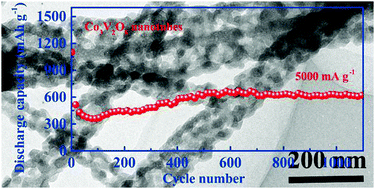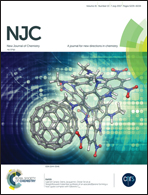Design and fabrication of Co3V2O8 nanotubes by electrospinning as a high-performance anode for lithium-ion batteries†
Abstract
Fabrication of hollow structures has attracted considerable attention as an effective strategy to improve the electrochemical performance of anode materials for lithium-ion batteries. Herein, we designed and fabricated Co3V2O8 nanotubes by blend electrospinning followed by annealing. We found the core–shell structure of precursor fibers and a modest annealing temperature with a low heating rate to be the two key factors contributing to the nanotube structure. When employed as anode material for lithium-ion batteries, Co3V2O8 nanotubes exhibited superior electrochemical lithium-storage performance with high specific capacity, notable rate performance and long cycle life. Particularly, a discharge capacity of 1040 mA h g−1 after 350 cycles at 1000 mA g−1 and a stable capacity of 630 mA h g−1 after long 1100 cycles at 5000 mA g−1 were maintained for the as-prepared Co3V2O8 nanotubes electrode. This excellent electrochemical performance can be ascribed to the unique nanotube structure with improved electrochemical kinetic and enhanced mechanical stability. Such an excellent specific capacity and cycling performance indicate that fabrication of nanotube structures by combining blend electrospinning with heat treatment is an effective strategy to develop cobalt-vanadium-based electrodes for high-performance lithium-ion batteries.



 Please wait while we load your content...
Please wait while we load your content...